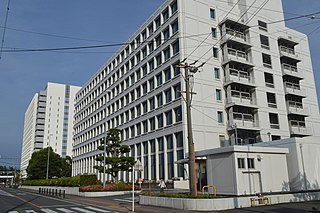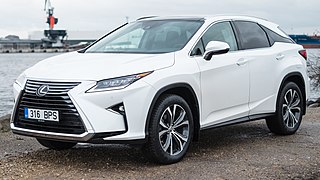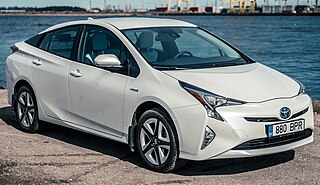
Toyota Motor Corporation is a Japanese multinational automotive manufacturer headquartered in Toyota City, Aichi, Japan. It was founded by Kiichiro Toyoda and incorporated on August 28, 1937. Toyota is one of the largest automobile manufacturers in the world, producing about 10 million vehicles per year.

A hybrid vehicle is one that uses two or more distinct types of power, such as submarines that use diesel when surfaced and batteries when submerged. Other means to store energy include pressurized fluid in hydraulic hybrids.

A vehicle start-stop system or stop-start system automatically shuts down and restarts the internal combustion engine to reduce the amount of time the engine spends idling, thereby reducing fuel consumption and emissions. This is most advantageous for vehicles which spend significant amounts of time waiting at traffic lights or frequently come to a stop in traffic jams. Start-stop technology may become more common with more stringent government fuel economy and emissions regulations. This feature is present in hybrid electric vehicles, but has also appeared in vehicles which lack a hybrid electric powertrain. For non-electric vehicles fuel economy gains from this technology are typically in the range of 3–10%, potentially as high as 12%. In the United States, idling wastes approximately 14.8 billion liters of gasoline per year.

An electric locomotive is a locomotive powered by electricity from overhead lines, a third rail or on-board energy storage such as a battery or a supercapacitor. Locomotives with on-board fuelled prime movers, such as diesel engines or gas turbines, are classed as diesel-electric or gas turbine-electric and not as electric locomotives, because the electric generator/motor combination serves only as a power transmission system.

Four-wheel drive, also called 4×4 or 4WD, refers to a two-axled vehicle drivetrain capable of providing torque to all of its wheels simultaneously. It may be full-time or on-demand, and is typically linked via a transfer case providing an additional output drive shaft and, in many instances, additional gear ranges.
Hybrid Synergy Drive (HSD), also known as Toyota Hybrid System II, is the brand name of Toyota Motor Corporation for the hybrid car drive train technology used in vehicles with the Toyota and Lexus marques. First introduced on the Prius, the technology is an option on several other Toyota and Lexus vehicles and has been adapted for the electric drive system of the hydrogen-powered Mirai, and for a plug-in hybrid version of the Prius. Previously, Toyota also licensed its HSD technology to Nissan for use in its Nissan Altima Hybrid. Its parts supplier Aisin Seiki Co. offers similar hybrid transmissions to other car companies.

Aisin Corporation is a Japanese corporation that develops and produces components and systems for the automotive industry. Aisin is a Fortune Global 500 company, ranked 359 on the 2020 rankings. Aisin is a member of the Toyota Group of companies.

DENSO Corporation is a global automotive components manufacturer headquartered in the city of Kariya, Aichi Prefecture, Japan.
Allison Transmission is an American manufacturer of commercial duty automatic transmissions and hybrid propulsion systems. Allison products are specified by over 250 vehicle manufacturers and are used in many market sectors including bus, refuse, fire, construction, distribution, military, and specialty applications.
Hybrid vehicle drivetrains transmit power to the driving wheels for hybrid vehicles. A hybrid vehicle has multiple forms of motive power.

Vehicle Dynamics Integrated Management (VDIM) is an integrated vehicle handling and software control system developed by Toyota. It involves an omnibus computer linkage of traction control, electronic stability control, electronic steering, and other systems, with the intent of improving responsiveness to driver input, performance, and overall safety. The system was first introduced in the Japanese domestic market in July 2004, when Toyota debuted VDIM on the Toyota Crown Majesta. This was followed by the VDIM's export debut on the third generation Lexus GS, which was launched in 2005. VDIM integrates the company's Electronically Controlled Brake (ECB), Anti-Lock Brakes (ABS), Electronic Brakeforce Distribution (EBD), Traction Control (TRC) and Vehicle Stability Control (VSC) active safety systems with the Adaptive Variable Suspension (AVS), Electric Power Steering (EPS) and Variable Gear Ratio Steering (VGRS) systems which previously worked independently using proprietary software. This way all the systems function together rather than the ECU prioritizing which is the most important. VDIM was initially designed for rear-wheel drive cars.
Toyota concept vehicles are transportation devices manufactured or designed by automobile company Toyota from 2000 to 2009. As their name suggests, these vehicles were concepts, and, as such, many were never released to dealerships. Many were developed in conjunction with other corporations such as Sony or Subaru.

Subaru (スバル) is the automobile manufacturing division of Japanese transportation conglomerate Subaru Corporation, the twenty-first largest automaker by production worldwide in 2017.

Active Power Stabilizer Suspension System (APSSS), is an electric active suspension system with active anti-roll bars developed by Toyota Motor Corporation for its high-end vehicles including Lexus models. By altering stabilizer bar stiffness, this system acts to reduce body tilt during cornering, keeping the vehicle more level during turns and improving handling, as opposed to the natural tendency of a vehicle to roll due to the lateral forces experienced during high-speed maneuvering. The active stabilizer system relies on vehicle body sensors and electric motors. The first production usage of this system was introduced in August 2005 with the Lexus GS430 sport sedan, followed by the 2008 Lexus LS 600h luxury sedan. The development of APSSS is claimed to be the world's first electric active stabilizer system. It is a system improvement of an earlier Toyota technology called Toyota TEMS (Toyota Electronic Modulated Suspension).

The Lexus RX is a luxury crossover SUV sold since 1998 by Lexus, a luxury division of Toyota. Originally released in its home market of Japan in late 1997 as the Toyota Harrier, export sales began in March 1998 as the Lexus RX. Considered as the first luxury crossover SUV, four generations of the RX have been produced to date, the first being compact in size, and the latter three classified as mid-size. Both front- and four-wheel drive configurations have been used on the RX series, and several gasoline powertrain options, including V6 engines and hybrid systems, have been offered. In the Lexus model lineup, the RX sits below the larger GX and LX, and above the smaller NX crossover with a lesser displacement inline-four engine. The name "RX" stands for "Radiant Crossover". It has also been labelled as "Recreational Cross Country" in some markets. The RX's current Toyota counterparts are the Highlander/Kluger; past counterparts were the Harrier and Venza.

A drivetrain is the group of components that deliver mechanical power from the prime mover to the driven components. In automotive engineering, the drivetrain is the components of a motor vehicle that deliver power to the drive wheels. This excludes the engine or motor that generates the power. In marine applications, the drive shaft will drive a propeller, thruster, or waterjet rather than a drive axle, while the actual engine might be similar to an automotive engine. Other machinery, equipment and vehicles may also use a drivetrain to deliver power from the engine(s) to the driven components.

The Toyota New Global Architecture are modular automobile platforms that underpin various Toyota and Lexus models starting with the fourth-generation Prius in late 2015. TNGA platforms accommodate different vehicle sizes and also front-, rear- and all-wheel drive configurations.

The Toyota bZ4X is a battery electric compact crossover SUV manufactured by Toyota. The vehicle debuted in April 2021 as the "bZ4X Concept". It is the first vehicle to be based on the e-TNGA platform co-developed by Toyota and Subaru, and the brand's first model to be part of their Toyota bZ series of zero-emissions vehicles.
An electromod is a vehicle that has been restored and modified by converting its drivetrain to operate as an electric vehicle (EV). The term is a portmanteau of electrification and restomod, itself a portmanteau of restoration and modification, a process which traditionally has been associated with classic cars. Most electromods are one-off custom vehicles performed by specialty repair shops and hobbyists, but starting in the late 2010s, automobile manufacturers have been building their own electromods, sometimes with the assistance of specialty shops, to publicize their shift to battery electric powertrains and to build interest in crate engine EV drivetrain products.













